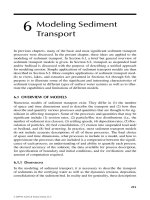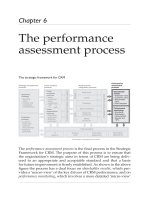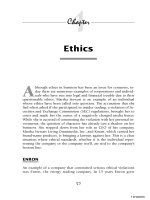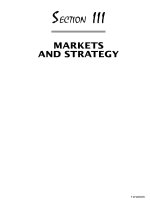MBA In A Day Chapter 6 potx
Bạn đang xem bản rút gọn của tài liệu. Xem và tải ngay bản đầy đủ của tài liệu tại đây (293.01 KB, 29 trang )
SECTION II
MONEY:
ECONOMICS,
FINANCE, AND
ACCOUNTING
ccc_stralser_secii_95-96.qxd 7/22/04 9:05 AM Page 95
TLFeBOOK
ccc_stralser_secii_95-96.qxd 7/22/04 9:05 AM Page 96
TLFeBOOK
6
Accounting
and Finance
A
ccounting is the process of recording, classifying, reporting,
and analyzing money. Accountants capture and record all the
transactions, operations, and activities that have financial
consequences for a business. Accountants are also involved in other
activities in finance that impact a business, such as weighing the
costs of new ventures, participating in strategies for mergers and ac-
quisitions, quality management, tracking financial performance, as
well as tax strategy.
While the accounting requirements of businesses vary, all organi-
zations need a way to keep track of the flow of money within them.
The responsibilities of the finance and accounting functional area
within an organization or of its chief financial officer (CFO) include:
✔ Facilitating operations—payroll, purchasing, cash collections,
cash disbursements.
✔ Management control—measuring actual performance against
goals and expectations.
✔ Management decision making—analyzing cash position to
make decisions.
Chapter
97
ccc_stralser_ch06_97-123.qxd 7/22/04 9:05 AM Page 97
TLFeBOOK
✔ External financial reports—financial statements prepared ac-
cording to generally accepted accounting principles (GAAP)
and available for audit.
✔ Tax returns—federal and state income taxes; property, sales,
and payroll taxes.
Accounting and finance are not intuitive. Many small businesses
hire accountants to set up and manage their books. Other companies
use accounting software such as QuickBooks. Accounting involves pe-
riodic reporting of financial data and includes:
✔ Business transactions. Businesses keep a daily record of
transactions in sales journals, cash-receipt journals, or cash-
disbursement journals.
✔ Debits and credits to a general ledger. An up-to-date general
ledger shows current information about accounts payable, ac-
counts receivable, owners’ equity, and other accounts.
✔ Making adjustments to the general ledger. General-ledger adjust-
ments let businesses account for items that don’t get recorded
in daily journals, such as bad debts and accrued interest or
taxes. By adjusting entries, businesses can match revenues
with expenses within each accounting period.
✔ Closing the books. After all revenues and expenses are ac-
counted for, any net profit gets posted in the owners’ equity
account. Revenue and expense accounts are always brought to
a zero balance before a new accounting cycle begins.
✔ Preparing financial statements. At the end of a period, busi-
nesses prepare financial reports—income statements, state-
ments of capital, balance sheets, cash-flow statements, and
other reports—that summarize all the financial activity for
that period.
CASH VERSUS ACCRUAL ACCOUNTING
The two principal methods of keeping track of the money that flows in
and out of a business are cash and accrual accounting. Most small
MONEY: ECONOMICS, FINANCE, AND ACCOUNTING
98
ccc_stralser_ch06_97-123.qxd 7/22/04 9:05 AM Page 98
TLFeBOOK
businesses use the cash method, in which income is reported in the
year it is received, and expenses are deducted in the year they are paid.
Under the accrual method, income is reported when it is earned and
expenses deducted when incurred, regardless of whether money has
changed hands yet.
Accrual Accounting
In an organization using the accrual method, an accountant records in-
come and expenses when they happen, not when they are actually re-
ceived or paid. In practical terms, this difference in timing is relevant if
your company keeps inventory on hand or handles transactions on
credit. For example, a consultant completes a project in January but
isn’t paid for it at the time. The business that has been serviced recog-
nizes all expenses in relation to that contract when they were incurred,
even though the consultant has not been paid. Both the income and
expenses are recorded for the current tax year, even if payment is re-
ceived and bills are paid the following February.
Cash Accounting
If an accountant uses the cash method, he/she counts income when it
is received and expenses when they are paid. Many small businesses,
especially retail businesses, use the cash basis method of accounting,
which is based on real-time cash flow. On the day a check is received, it
becomes a cash receipt.
DOUBLE-ENTRY BOOKKEEPING
Without a system to record and track the flow of money within a
firm, a business cannot accurately conduct its operating functions or
make clear operating decisions. In order to effectively operate, a
business must ensure that the cash inflow from operating, financing,
and investing activities is in balance with the cash outflows that are
associated with expenditures. To do this, accountants use a system
of double-entry accounting to debit (remove) or credit (add) money
as it flows into and out of their business. Double entry requires two
Accounting and Finance
99
ccc_stralser_ch06_97-123.qxd 7/22/04 9:05 AM Page 99
TLFeBOOK
entries per transaction, which provides cross-checks and decreases
errors. In the record of every financial transaction the following
equation remains in balance at all times:
Assets = Liabilities + Owners’ Equity (Capital)
Assets are what a company owns, such as equipment, buildings, and
inventory. Claims on assets include liabilities and owners’ (stockhold-
ers) equity. Liabilities are what a company owes, such as notes payable,
trade accounts payable, and bonds. Owners’ equity represents the
claims of owners against the business.
The double-entry system provides checks and balances that en-
sure that the books are always kept in balance. Each transaction is
recorded as a debit or a credit, with total assets equaling the sum total
of liabilities and owners’ equity.
ACCOUNTING TERMS AND CONCEPTS
There are a few accounting terms and concepts that a business man-
ager must be familiar with in order to make setting up an accounting
system easier.
Debits and Credits
An understanding of debits and credits is essential in the effective us-
age of any accounting system. Every accounting entry in the general
ledger contains both a debit and a credit. Further, all debits must equal
all credits. If they don’t, the double-entry system is out of balance.
Therefore, the accounting system must have a mechanism to ensure
that all entries balance. Indeed, most automated accounting systems
won’t let you enter an out-of-balance entry; they will just beep at you
until you fix your error. Depending on the type of accounting system, a
debit or credit will either increase or decrease the account balance. For
every increase in one account, there is an opposite (and equal) de-
crease in another. That’s what keeps the entry in balance.
MONEY: ECONOMICS, FINANCE, AND ACCOUNTING
100
ccc_stralser_ch06_97-123.qxd 7/22/04 9:05 AM Page 100
TLFeBOOK
Assets and Liabilities
Balance sheet accounts are the assets and liabilities for a firm, which,
as discussed, must balance.
Identifying Assets. An asset is any item of value owned by a
business. A firm’s assets are listed on its balance sheet, where they
are set off against its liabilities. Assets may include factories, land,
inventories, vehicles, and other items. Some assets (short-term as-
sets), like cash, are easy to value and liquidate, while others (long-
term assets), such as buildings and farmland, are difficult to value
and take longer to liquidate. These kinds of assets are collectively
known as tangible assets. Intangible assets, like a valued brand name
such as BMW, don’t show up on a balance sheet, but do contribute to
the value of the firm. There are many other intangible assets owned
by a company. Patents, the exclusive right to use a trademark, and
goodwill from the acquisition of another company are such intangi-
ble assets. Generally, the value of intangible assets is whatever both
parties agree to when the assets are created. In the case of a patent,
the value is often linked to its development costs. Goodwill is often
the difference between the purchase price of a company and the
value of the assets acquired (net of accumulated depreciation). Even
something that is not physically in hand, such as accounts receiv-
able, is an asset because a company has claim to money due from
a customer.
Identifying Liabilities. Liabilities are the opposite of assets. These
are the obligations of one company to another. Accounts payable are li-
abilities and represent a company’s future duty to pay a vendor. So is
the loan you took from a bank. A business organizes liabilities into
short-term and long-term categories on the balance sheet. Long-term
debt (claims due in more than one year) and short-term debt (claims
due within a year) are liabilities because they are claims against the
business. If you were a bank, a customer’s deposits would be a liability
for accounting purposes, because they represent future claims against
the bank.
Accounting and Finance
101
ccc_stralser_ch06_97-123.qxd 7/22/04 9:05 AM Page 101
TLFeBOOK
Owners’ Equity
Owners’ equity is the difference between assets and liabilities; it in-
creases and decreases just like they do. Owners’ equity includes factors
like partners’ capital accounts, stock, and retained earnings. Stock-
holders’ equity is also what would belong to the company’s owners—
the holders of its common stock—after selling the assets and paying
off the creditors. Literally, it is paid-in capital plus retained earnings.
Retained earnings are the accumulated profits after dividends to
common shareholders have been paid. At the end of one accounting
year, all the income and expense accounts are compared to one an-
other, and the difference (profit or loss for the year) is moved into the
retained earnings account.
Income and Expenses
Further down in the chart of accounts (usually after the owners’ equity
section) come the income and expense accounts. Most companies
want to keep track of just where they get income and where it goes,
and these accounts provide that information.
Income Accounts. A business may want to establish an income ac-
count for different income-generating departments of a business. In
that way, it can identify exactly where the income is coming from, and
the income of the various departments can be added together. Different
income accounts would be:
✔ Sales revenue.
✔ Interest income.
✔ Income from sale of assets.
Expense Accounts. Most companies have a separate account for
each type of expense they incur. A company probably incurs much the
same expenses month after month; thus, once they are established, the
expense accounts won’t vary much from month to month. Typical ex-
pense accounts include:
✔ Salaries and wages.
✔ Telephones.
MONEY: ECONOMICS, FINANCE, AND ACCOUNTING
102
ccc_stralser_ch06_97-123.qxd 7/22/04 9:05 AM Page 102
TLFeBOOK
✔ Utilities.
✔ Repairs.
✔ Maintenance.
✔ Depreciation.
✔ Amortization.
✔ Interest.
✔ Rent.
GENERAL LEDGER
The core of a company’s financial records is maintained as a “general
ledger.” These records constitute the central “books” of all financial
transactions since day one in the life of the company.
In setting up the general ledger, one must be cognizant of two
points: (1) linkage to the company’s financial reports and (2) establish-
ment of opening balances.
The two primary financial documents of any company are the
balance sheet and the profit and loss statement (income statement),
both of which are drawn directly from the company’s general ledger.
The general ledger accrues the balances that make up the line items
on these reports, and the changes are reflected in the profit and loss
statement.
Every account that is on a chart of accounts will be included in a
general ledger, which should be set up in the same order as the chart of
accounts. While the general ledger does not include every single ac-
counting entry in a given period, it does reflect a summary of all trans-
actions made.
If a business is small and cash-based, a business can set up much
of a general ledger out of a checkbook. The checkbook includes several
pieces of information vital to the general ledger—cumulative cash bal-
ance, date of the entry, amount of the entry, and purpose of the entry.
Even for a cash-based business, a checkbook cannot be a sole source
for establishing a balance sheet.
An important component of any general ledger is source docu-
ments. Two examples of source documents are copies of invoices to
Accounting and Finance
103
ccc_stralser_ch06_97-123.qxd 7/22/04 9:05 AM Page 103
TLFeBOOK
customers and from suppliers. Source documents are critical in that
they provide an audit trail in case you or someone else has to go back
and study financial transactions made in a business. For instance, a
customer might claim that he never received an invoice from you. A
source document will prove otherwise. And source documents are a re-
quired component for an accountant at tax time. Other examples of
source documents include canceled checks, utility bills, payroll tax
records, and loan statements.
All general ledger entries are double entries. This makes sense be-
cause for every financial transaction in a business, the money (or com-
mitment to pay) goes from one place to another. For instance, when a
payroll check is written, the money flows out of a payroll account
(cash) into the hands of an employee (an expense). When goods are
sold on account, a record of the sale (income) is generated; but there
must also be a journal entry to make sure that the funds are collected
from that account later (an account receivable). As discussed earlier,
the system used in recording entries on a general ledger is called a sys-
tem of debits and credits.
As explained in a previous section, for every debit there should be
an equal and offsetting credit. It is when the debits and credits are not
equal or do not offset one another that the books don’t balance. A key
advantage of any automated bookkeeping system is that it polices debit
and credit entries as they are made, making it far more difficult for the
accounts not to balance.
COMPONENTS OF THE ACCOUNTING SYSTEM
Think of the accounting system as a wheel, and the hub as the gen-
eral ledger. Feeding the hub information are the spokes of the wheel.
These include:
✔ Payroll.
✔ Accounts payable.
✔ Fixed assets.
✔ Inventory control.
✔ Accounts receivable.
MONEY: ECONOMICS, FINANCE, AND ACCOUNTING
104
ccc_stralser_ch06_97-123.qxd 7/22/04 9:05 AM Page 104
TLFeBOOK
✔ Order entry.
✔ Cost accounting.
The following is an exploration of some of the important ele-
ments of the accounting system.
Payroll
Payroll accounting can be quite a challenge for the new business
owner. There are many federal and state laws that regulate what must
be tracked related to payroll. A business may face fines for maintaining
incomplete or nonconforming records. Many small business owners
outsource their payroll services and by so doing guarantee their com-
pliance with all applicable laws.
If payroll is maintained in-house, it is advised that a business use
an automated payroll system. Even if the books are done manually, an
automated payroll system will save valuable time and help consider-
ably with compliance.
Accounts Payable
Accounts payable represent bills from suppliers for goods or services
purchased on credit. Generally this debt must be paid within 12
months. It is important to track accounts payable in a timely manner
in order to know how much each supplier is owed and when pay-
ment is due. If a business has a timely system in place to manage ac-
counts payable, it may often be able to take advantage of discounts
that are provided for timely payments. A poorly managed supplier
system can damage a relationship with a supplier and earn a business
a poor credit rating.
Fixed Assets
Fixed assets are commonly recognized as long-lived property owned
by a firm that is used in the production of its income. Fixed assets in-
clude real estate, facilities, and equipment. Other types of assets in-
clude intangible fixed assets, such as patents, trademarks, and
Accounting and Finance
105
ccc_stralser_ch06_97-123.qxd 7/22/04 9:05 AM Page 105
TLFeBOOK
customer recognition. Fixed assets are items that are for long-term use,
generally five years or more. They are not bought and sold in the nor-
mal course of business operation.
In an accrual system of accounting, fixed assets are not recorded
when they are purchased, but rather they are expensed over a period of
time that coincides with the useful life of the item (the amount of time
the asset is expected to last). This process is known as depreciation.
Most businesses that own fixed assets keep subledgers for each asset
category as well as for each depreciation schedule.
In most cases, depreciation is easy to compute. The cost of the as-
set is divided by its useful life. For instance, a $50,000 piece of equip-
ment with a five-year useful life would be depreciated at a rate of
$10,000 per year. This is known as straight-line depreciation.
There are other more complicated methods of fixed-asset depreci-
ation that allow for accelerated depreciation on the front end, which is
advantageous from a tax standpoint. You should seek the advice of a
certified public accountant (CPA) before setting up depreciation
schedules for fixed-asset purchases.
Inventory Control
A good inventory-control feature is an essential part of a bookkeeping
system. If you are going to be manufacturing products, you will have
to track raw materials, work in process, and finished goods, and sepa-
rate subledgers should be established for each of these inventory cate-
gories. Even if you are a wholesaler or retailer, you will be selling many
different types of inventory and will need an effective system to track
each inventory item offered for sale.
Another key reason to track inventory very closely is the direct re-
lationship to cost of goods sold. Because nearly all businesses that stock
inventory are required to use the accrual method for accounting, good
inventory records are a must for accurately tracking the material cost
associated with each item sold. From a management standpoint, track-
ing inventory is also important. An effective and up-to-date inventory-
control system will provide you with the following critical information:
✔ Which items sell well, and which items are slow moving.
✔ When to order more raw materials or more items.
MONEY: ECONOMICS, FINANCE, AND ACCOUNTING
106
ccc_stralser_ch06_97-123.qxd 7/22/04 9:05 AM Page 106
TLFeBOOK
✔ Where in the warehouse the inventory is stored when it comes
time to ship it.
✔ Number of days in the production process for each item.
✔ Typical order of key customers.
✔ Minimum inventory level needed to meet daily orders.
Accounts Receivable
If you plan to sell goods or services on account in a business, you
will need a method of tracking who owes you how much and when
it is due, the purpose of the accounts receivable subledger. If you
will be selling to a number of different customers, an automated sys-
tem is a must.
A good bookkeeping software system will allow you to set up
subledgers for each customer. Thus, when a sale is made on account,
you can track it specifically to the customer. This is essential to ensure
that billing and collection are done in a timely manner.
ORGANIZING THE ACCOUNTING
AND FINANCE DEPARTMENT
Organize a small-business accounting system by function. Often there
is just one person in the office to do all the transaction entries. From
an internal control standpoint, this isn’t desirable because it opens the
door for fraud and embezzlement. Companies with more people as-
signed to accounting functions don’t pose as much of a threat for fraud
perpetrated by a single person.
Having the same person draft the checks and reconcile the
checking account is not a good example of how to assign accounting
duties. Small businesses often can’t afford the number of people
needed for an adequate separation of duties; however, setting up a
smart internal control structure within a new accounting system helps
mitigate that risk.
Accounting and Finance
107
ccc_stralser_ch06_97-123.qxd 7/22/04 9:05 AM Page 107
TLFeBOOK
Assignment of Duties
Figure out who is going to do what in a new accounting system. A
business needs to cover the following accounting responsibilities:
✔ Payroll. (Even if the business uses an outside payroll service,
someone must be in control and be responsible.)
✔ Accounts payable.
✔ Fixed assets.
✔ Inventory control.
✔ Accounts receivable.
✔ Order entry.
✔ Cost accounting.
✔ Monthly reporting.
✔ Internal accounting control.
✔ Overall responsibility for the accounting system.
✔ Management of the computer system (if you’re using one).
In many cases the same person will do many of these things. The
person assigned to be in overall charge of the system should be the one
who is most familiar with accounting. If you are just starting a com-
pany, you will want to think about the background of the new employ-
ees. At least one of them should have the capacity and integrity to run
the accounting system. To determine someone’s expertise in a field,
one of the following steps would be appropriate:
✔ Have the applicant be interviewed by an expert. Your own
CPA will probably be glad to interview a few for you.
✔ Carefully check references from past jobs. Ask detailed ques-
tions on exactly what the candidate did in the accounting
function. Compare the reference source’s answers with what
the candidate said.
✔ Ask some accounting questions. This will allow you to assess
the applicant’s comfort with the language of accounting.
MONEY: ECONOMICS, FINANCE, AND ACCOUNTING
108
ccc_stralser_ch06_97-123.qxd 7/22/04 9:05 AM Page 108
TLFeBOOK
PRACTICAL ACCOUNTING
Though accounting serves a rather perfunctory purpose of control and
assessment of the firm’s financial performance, there are other, practi-
cal financial activities to consider.
Credit Checking Potential Customers
When a business extends credit, it is in effect loaning customers
money, and any company wants to be reasonably sure that the money
will be paid back. The best assurance of being able to collect is to
check each customer’s credit history before extending credit. That can
be as simple as a phone call to a bank.
However a business chooses to check a customer, it will want to
build a credit relationship slowly and carefully. Remember, not every
customer deserves the same credit terms; thus, it’s best to approach
credit on a case-by-case basis. One thing to note is how long the com-
pany has been in business. Companies that have been around for at
least five years are more likely to pay their bills on time—or they
wouldn’t be around anymore. The key ways to check a customer’s
credit include credit reports, credit references, financial statements,
personal credit reports on the owner or CEO, and letters of credit.
Credit Reports. It’s always a good idea to obtain a potential cus-
tomer’s credit report before you extend credit. Credit reports range in
price from $15 for a one-page report to more than $1,000 for a detailed
filing. The reports show historical payment data; bankruptcy records;
any lawsuits, liens, or court judgments against a company; and a risk
rating that predicts how likely customers are to pay their bills. Even if
a prospective customer has little or no credit history, running a credit
report is still worthwhile because it will reveal relevant data, including
bankruptcy filings, corporate records, fictitious business name filings,
court judgments, and tax liens.
Credit reporting agencies can send a credit report via mail, fax, or
via the World Wide Web. Some agencies also provide reports online. If
you request a considerable number of reports, you might be able to
sign a contract that will reduce a per-report price.
Accounting and Finance
109
ccc_stralser_ch06_97-123.qxd 7/22/04 9:05 AM Page 109
TLFeBOOK
Credit References. In addition to credit reports, or for compa-
nies not covered by commercial credit reporting agencies, you may
want to check a customer’s credit references yourself. These refer-
ences can be informative, but they aren’t foolproof. After all, a cus-
tomer picks his or her own references. To gain a more realistic
picture, ask a customer for a comprehensive list of suppliers. Call
several and ask if a potential customer owes them money. If so, find
out if payments are being made in a timely manner. Ask these sup-
pliers for names of other suppliers and other customers and contact
them as references.
You might want to call the customer’s banker as well. While
specific information may be inappropriate or illegal for a banker to
provide, you may seek some general information. Ask how long
the bank has had a relationship with the company. Has the bank
given it any credit? If a loan was given, did the company meet its
obligations?
Personal Credit Report of the Owner or CEO. When contem-
plating doing business with a new, closely held private company, it
may not be possible to obtain a credit report, references, or financial
statements. However, you can run a personal credit check on the
owner or CEO of the business. If that person has a strong credit his-
tory, it’s likely he or she will see to it that the company pays its bills
on time. If the owner or CEO has a history of debt dodging or late
bill payment, the company could follow suit. If a review raises con-
cerns, schedule a meeting with management to address the issues.
You may want to discuss credit issues with any investors in the firm
as well.
Red Flags. In addition to the standard inquiries into a company’s
credit situation, you should keep your eyes open for other things that
could indicate a credit problem:
Does the business engage in unusual price-cutting or discount-
ing strategies? Such practices may hinder the company’s ability to
pay what it owes in a timely fashion. Does the company already have
trade credit relationships with other companies? You don’t want to
work with a customer that is already overextended. Are any company
MONEY: ECONOMICS, FINANCE, AND ACCOUNTING
110
ccc_stralser_ch06_97-123.qxd 7/22/04 9:05 AM Page 110
TLFeBOOK
assets already pledged as collateral? Does the company operate in a
cyclical industry or in a business sector that is prone to seasonal
turns? What is the general economic climate? When business is good
you may be more willing to extend credit. When things are slow,
however, you may want to be more tightfisted in extending credit to
higher-risk customers.
Finally, pay attention to the results of research. Sometimes “no” is
the right answer when it comes to extending credit, no matter how
much you want the business.
Reading a Credit Report. A credit report is a snapshot of a
company’s or an individual’s financial activities. Credit reports typi-
cally include historical payment data, bankruptcy records, Uniform
Commercial Code (UCC) filings, bank loan information, leases, pay-
ment trends, and comparative industry data.
A typical credit report on a company contains its corporate name,
address, and telephone number. It also includes the name of the chief
executive officer, the company’s Standard Industrial Classification
(SIC) code, a description of its line of business, and the date when the
company began operations. Also included are the number of employ-
ees, sales, and a net worth figure. In many cases, a report includes a
numerical credit rating.
Financial information can run the gamut from basic sales and
payment data to detailed transactional analysis. The information
should include a summary of any lawsuits, liens, or court judgments
that are outstanding, plus any relevant bankruptcy filings. If avail-
able, there will also be information on changes in ownership, reloca-
tions, company acquisitions, and publicly reported news events,
including fires or natural disasters. The amount of information de-
pends on the stature of the company and whether it is publicly
owned.
Most credit report services focus on publicly held companies.
Credit rating resources for privately held and newer companies are less
formalized. To check payment practices for smaller companies, try
talking to their customers, suppliers, and bankers.
Remember, too, that while credit reports can be important tools,
they’re not ends in themselves. Before making decisions based on
Accounting and Finance
111
ccc_stralser_ch06_97-123.qxd 7/22/04 9:05 AM Page 111
TLFeBOOK
credit reports, you’ll want to back up the information with data
gleaned from other kinds of company research, as well as from cus-
tomers, employees, and personal contacts.
Preventing Overdue Accounts
The best way to prevent overdue accounts is to avoid doing business
with customers who have bad credit histories. However, if you limited
yourself to doing business with companies with spotless credit records,
a pool of potential customers would be quite small. And unfortunately,
with a growing business you often have no choice but to do business
with anyone who wants to do business with you. Even then, you don’t
always have complete control of the terms of sales agreements. The re-
ality is that the biggest and best clients want to be billed quarterly and
then have 60 days to pay you. And you certainly don’t want to cut off
those clients.
While you don’t want to destroy any potential or established busi-
ness relationships by laying down harsh payment terms, you must take
some control of accounts receivable to avoid wreaking havoc with a
cash flow. You’re not a bank, after all. The following five steps can help
cash flow without endangering it.
1. Watch for new customers with bad credit history. You can’t
expect that a company or a person with a history of bounc-
ing checks or paying their bills late will change their ways
when dealing with you. If you must do business with the
chronically late, lay down credit rules early and firmly and
start the relationship off slowly. Keep the amount of product
or services you offer a company with an iffy credit record to
a minimum until they’ve proven themselves worthy. And no
matter how much you need the business, never start doing
business with another person or company until you have a
signed contract clearly stating and agreeing to payment
terms.
2. Once you begin doing business with someone, make sure
you stamp invoices with the date that payment is due. Don’t
rely on the customer to look at the invoice date and add 30
MONEY: ECONOMICS, FINANCE, AND ACCOUNTING
112
ccc_stralser_ch06_97-123.qxd 7/22/04 9:05 AM Page 112
TLFeBOOK
days—or whatever the payment terms are—to determine the
pay date.
3. Offer discounts for early payment and add interest to late pay-
ments. A typical discount is 2 to 3 percent off the total if the
bill is paid within 10 days of the invoice date. The maximum
amount of interest that can be charged varies by state.
4. Phone customers and start trying to collect the day after a pay-
ment is due. Never wait—let them know that you keep close
track of accounts receivable.
5. Until customers pay their bills, don’t do any more business
with them. Do not bend on this rule—you’ll only cause
yourself more problems and scuttle any chance of collecting
what you are owed. If you really want to keep doing busi-
ness with a customer who owes you, insist that any new
products or services they receive from you are COD—cash
on delivery.
Collection Agencies
It’s easy to extend too much credit when trying to entice companies
into doing more business. Extending too much credit can lead to un-
paid accounts, which can quickly and severely limit the cash you have
to grow a business. If you don’t stay on top of overdue accounts, the
chance of collecting the money decreases over time.
One way to recover more from delinquent accounts is to hire a
collection agency. A collection agency locates debtors and collects the
money you are owed. If brought on board early, a collection agency can
often recover a substantial portion of unpaid accounts.
In addition to increasing chances of actually getting paid, using
an agency saves you time and money—two of your most valuable
resources. With their custom-designed phone systems, computers, and
software, collection agencies can be more effective in recovering delin-
quent accounts than you can. Although collection agencies charge be-
tween 15 and 50 percent of what they recover, you still end up with
more than you probably could have collected on your own.
When selecting an agency, you should think about these
considerations.
Accounting and Finance
113
ccc_stralser_ch06_97-123.qxd 7/22/04 9:05 AM Page 113
TLFeBOOK
Find out if the collection agency is a member of the American
Collection Agency or the Commercial Law League of America, which
require that their members adhere to a code of ethics and are familiar
with the Fair Debt Collection Practices Act.
Make sure the agency has insurance that will protect a business if
the agency errs during the collections process.
Ask the agency to disclose its typical recovery rate and provide
you with a list of references. Contact some of the companies on the list
and find out how long it took the agency to collect on late accounts, if
it collected the whole debt or a portion of what was owed, and if the
companies were satisfied with the agency’s collection efforts.
GAAP Accounting Rules
Generally accepted accounting principles (GAAP) is a set of nationally
(United States) recognized accounting standards. Using GAAP ac-
counting standards, costs and benefits are accounted for in a recog-
nized way to assure consistency with other firms’ accounting
principles and for comparing various projects and investments with
one another.
Chart of Accounts
The first step in setting up an accounting system is deciding what you
want to track. A chart of accounts is simply a list and is kept by every
business to record and follow specific entries. Whether you decide to
use a manual system or a software program, you can customize the
chart of accounts to a particular business.
Account numbers are used as an easy account identification sys-
tem. The chart of accounts is the fuel for an accounting system. After
the chart of accounts, you establish a general ledger system, which is
the engine that actually runs an accounting system on a daily basis.
The chart of accounts is the foundation on which you will
build an accounting system. Take care to set up a chart of accounts
correctly the first time. Keep account descriptions as concise as pos-
sible, and leave plenty of room in a numbering system to add ac-
counts in the future.
MONEY: ECONOMICS, FINANCE, AND ACCOUNTING
114
ccc_stralser_ch06_97-123.qxd 7/22/04 9:05 AM Page 114
TLFeBOOK
MANAGERIAL ACCOUNTING
AND FINANCIAL MANAGEMENT
There are several concepts found in accounting systems that
serve as decision-making tools for the business owner, manager, or
professional.
Fixed, Variable, and Other Types of Costs
Fixed, variable, incremental, opportunity, and sunk costs describe
different types of costs to the business.
Fixed costs include all costs that do not vary with activity for an
accounting period. Fixed costs are the inevitable costs that must be
paid at any time regardless of the level of output and of the amount of
resources used. A fixed cost does not, in theory, vary with activity or
sales. Such costs often include offices, factories, depreciation, and in-
surance or professional indemnity.
Variable costs are costs that are some function of activity. Vari-
able costs include the obvious things such as sales commissions, raw
materials, components, distribution, and deal financing.
Incremental costs are those costs (or revenues) that change due
to an incremental change in activity, as compared to those that are un-
affected. They are costs that would occur if a particular course of ac-
tion were taken.
Opportunity costs refer to alternatives or opportunities that are
sacrificed in favor of the chosen solution. Because resources are lim-
ited, any decision in favor of one project (service, goods, upgrade, etc.)
means doing without something else.
Sunk costs include prior costs that cannot be recovered.
Activity-Based Costing
A financial analysis costing methodology associates specific efforts and
personnel with specific tasks, allowing the tasks to be analyzed and the
current costs dedicated to specific tasks to be well understood. A simple
activity-based costing analysis can be an analysis of work performed
Accounting and Finance
115
ccc_stralser_ch06_97-123.qxd 7/22/04 9:05 AM Page 115
TLFeBOOK
by a specific employee or work unit in a year and the cost associated
with each time the work is done to arrive at an annual cost for that
activity. For example, a company considering outsourcing its payroll
function may analyze how many people in the human resources and
accounting departments are involved in processing payroll each pay
period, assess the associated salaries and overhead, multiply by the
number of pay periods per year, and arrive at an activity-based cost
of payroll processing. This assessment may then be compared to the
quote from an outsource payroll preparation company to determine
the relative cost/benefit of outsourcing versus internally processing
the payroll function.
TAXES
Small Business Tax Basics
Next to profits, taxes may be the most important issue facing every
small business. You’ll want to be sure that you are meeting all your re-
sponsibilities to the tax collector—and also seizing every opportunity
to reduce taxes. Use these tax tips to make sure you’re not giving Uncle
Sam more than his due.
Writing It Off: Deductions
You can deduct all “ordinary and necessary” business expenses from
revenues to reduce taxable income (see “Tax Deductions” subsection
later in the chapter). Some deductions are obvious—expenditures in
such areas as business travel, equipment, salaries, or rent. But the rules
governing write-offs aren’t always simple. Don’t overlook the following
potential deductions:
✔ Business losses. Business losses can be deducted against per-
sonal income to reduce taxes. If losses exceed personal income
this year, you can use some of this year’s business loss to re-
duce a taxable income in future years.
MONEY: ECONOMICS, FINANCE, AND ACCOUNTING
116
ccc_stralser_ch06_97-123.qxd 7/22/04 9:05 AM Page 116
TLFeBOOK
✔ Employee taxes. If you hire employees, you’ll have to pay—or
withhold from their salaries—a variety of taxes:
Withholding. Social Security (FICA), Medicare, and fed-
eral and state income taxes must be withheld from em-
ployees’ pay.
Employer matching. You must match the FICA and Medicare
taxes and pay them along with employees.
Unemployment tax. Federal and state unemployment taxes.
Quarterly Estimated Taxes
This area of the tax code trips up many an entrepreneur and is espe-
cially vexing for home-based businesses. Failure to keep up with an es-
timated tax bill can create cash flow problems as well as the potential
for punishing Internal Revenue Service (IRS) penalties. The antidote is
simple—know your responsibilities:
✔ Who should pay? You probably must pay quarterly esti-
mated taxes if you expect a total tax bill in a given year to
exceed $500.
✔ How much should you pay? By the end of the year, you must
pay either 90 percent of the tax you owe for the year or 100
percent of last year’s tax amount (the figure is 110 percent if
your income exceeds $150,000). An accountant can help you
calculate payments. Otherwise, you can subtract expenses
from your income each quarter and apply an income tax rate
(and any self-employment tax rate) to the resulting figure
(your quarterly profit).
Sales Taxes
Many services are under the taxable radar screen, but most products
are taxable (typical exceptions are food and prescription drugs). States
keep adding to the list of taxable services, however, so check with a
state’s department of taxation to find out if you should charge sales tax
on services. If you do sell a product or service that is subject to sales
Accounting and Finance
117
ccc_stralser_ch06_97-123.qxd 7/22/04 9:05 AM Page 117
TLFeBOOK
tax, you must register with the state’s tax department. Then you must
track taxable and nontaxable sales and include that information on a
sales tax return.
Deadlines
As a salaried worker, you have to remember just one or two tax-related
dates: April 15 and perhaps December 31. But other dates may matter
just as much or more when you are involved in your own business:
✔ Annual returns. Most annual returns are due April 15 for unin-
corporated companies and S corporations. A C corporation,
though, must file an annual corporate return within two and a
half months after the close of its fiscal year.
✔ Estimated taxes. Estimated taxes are due four times a year:
April 15, June 15, September 15, and January 15.
✔ Sales taxes. Sales taxes are due quarterly or monthly, depend-
ing on the rules in a state.
✔ Employee taxes. Depending on the size of a payroll, employee
taxes are due weekly, monthly, or quarterly.
Taxes and Incorporation
For federal tax purposes, it’s often best for a start-up company to be an
S corporation rather than a regular corporation. This is so even though
recent changes in tax rates have made the decision a bit more complex.
Still, to make sure an S corporation is best for you, speak to a knowl-
edgeable accountant or tax adviser. Also keep in mind that a limited li-
ability company (LLC) may be an even better choice.
Starting as an S corporation rather than a regular corporation may
be wise for two reasons:
1. Income from an S corporation is taxed at only one level rather
than two—a total tax bill will likely be less.
2. If a business operates at a loss the first year, you can pass that
loss through to a personal income tax return, using it to offset
MONEY: ECONOMICS, FINANCE, AND ACCOUNTING
118
ccc_stralser_ch06_97-123.qxd 7/22/04 9:05 AM Page 118
TLFeBOOK
income that you (and a spouse, if you’re married) may have
from other sources.
Your decision to be an S corporation isn’t permanent. If you later
find there are tax advantages to being a regular corporation, you can
easily change an S corporation status.
Employee Taxes
A business is responsible for collecting and filing some taxes on behalf
of employees. The following is an overview of what you have to do to
withhold and match taxes on an employee’s paychecks:
✔ Get an employer identification number (EIN). A business must
report employment taxes or give tax statements to employees;
you need an EIN to do this. Get Form SS-4 (Application for
Employer Identification Number) from the Web, or by calling
1-800-Tax-Form (1-800-829-3676).
✔ Deposit employee withholdings on time. Instead of paying the
federal government directly, you deposit with an authorized
financial institution such as a commercial bank (1) the
income tax you have withheld and (2) both the employer
portion and the employee portion of Social Security and
Medicare taxes.
✔ Issue Form 1099-Misc to independent contractors. Doctors,
lawyers, veterinarians, contractors, direct sellers, qualified
real estate agents, and others who pursue an independent
trade in which they offer their services to the public are usu-
ally not employees but independent contractors. A worker is
defined as an independent contractor if he controls what he
does and how the work is performed. What matters is that
you have the right to control the details of how the services
are performed.
✔ Avoid payment penalties. For an employer, paying and report-
ing employment taxes is a “fiduciary responsibility,” and that
responsibility is taken very seriously by Congress, the IRS,
Accounting and Finance
119
ccc_stralser_ch06_97-123.qxd 7/22/04 9:05 AM Page 119
TLFeBOOK









